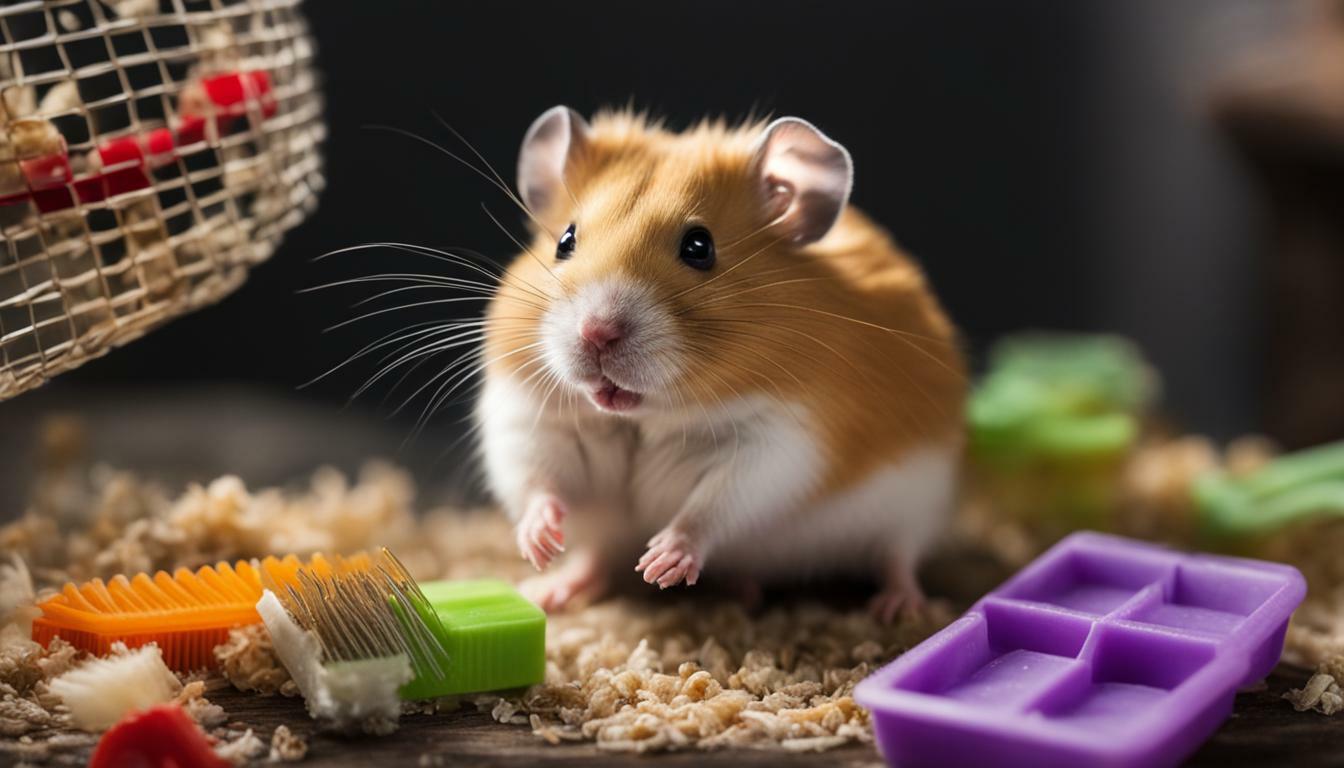If you suspect that your hamster has fleas, it’s crucial to act quickly to alleviate their discomfort and prevent the infestation from spreading. Fleas can infest hamsters through contact with other animals or their bedding. Recognizing the signs of fleas in hamsters, seeking appropriate treatment, and implementing prevention methods are essential for the well-being of your furry friend.
Key Takeaways:
- Signs of fleas in hamsters include excessive itching, hair loss, and the presence of flea droppings.
- Consult a veterinarian for proper diagnosis and treatment of flea infestations in hamsters.
- Remove and replace the hamster’s bedding, and thoroughly clean their cage to eliminate fleas.
- Consider treating other pets in the household and the home itself to prevent the continuation of the infestation.
- Regularly change the hamster’s bedding and maintain cleanliness to prevent future flea infestations.
Signs of Fleas in Hamsters
Before taking any action, it’s important to determine whether your hamster is indeed infested with fleas by looking for specific signs and symptoms. Flea infestations can cause discomfort and health issues for your furry friend, so being aware of the following indicators is crucial.
One of the most common signs of fleas in hamsters is excessive itching. If you notice your hamster scratching themselves more frequently than usual or chewing at their fur, it could be a sign of flea bites. Another red flag is hair loss, particularly around the hamster’s neck, back, or tail. Fleas often target these areas, causing hair to thin out or fall off.
You may also observe tiny black specks on your hamster’s fur or bedding. These specks are flea droppings, which consist of digested blood. To confirm their presence, take a white paper towel and gently rub it on your hamster’s fur. If you see reddish-brown stains on the towel, it is likely flea droppings.
If you suspect that your hamster has fleas based on these signs, it’s important to take action promptly. Consulting a veterinarian is recommended, as they can provide appropriate treatment for your hamster’s specific needs. In the meantime, ensure that you remove and replace the hamster’s bedding and thoroughly clean their cage to minimize the flea population.
While addressing the flea infestation, it’s important to consider other pets in the household as well. Fleas can easily spread among animals, so treating all pets simultaneously is essential to prevent the infestation from persisting. Additionally, taking measures to treat your home, such as vacuuming regularly and washing pet bedding, will help eliminate any remaining fleas.
To prevent future flea infestations, it’s advisable to regularly change your hamster’s bedding and keep their environment clean. This includes routine cleaning of their cage, as well as maintaining proper hygiene for your hamster. Regular veterinary check-ups can also help ensure your hamster’s overall health and catch any potential flea problems early on.
Remember, acting quickly and consistently is key in treating and preventing fleas in hamsters. By staying vigilant and providing the necessary care, you can keep your hamster happy and free from flea infestations.
| Signs of Fleas in Hamsters | Treatment and Prevention |
|---|---|
|
|
Treating Flea Infestations in Hamsters
Treating flea infestations in hamsters requires a comprehensive approach that involves professional guidance and thorough cleaning of their environment. If you suspect that your hamster has fleas, it is crucial to seek the assistance of a veterinarian who can provide the appropriate treatment. They may prescribe medication or recommend flea control products that are safe for your hamster.
While consulting a veterinarian is essential, there are also steps you can take at home to help get rid of the fleas. Start by removing and replacing your hamster’s bedding, as this is where the fleas might be hiding and reproducing. Wash their bedding thoroughly in hot water to kill any remaining fleas and their eggs.
Cleaning your hamster’s cage is equally important in the treatment process. Use a mild disinfectant to thoroughly clean all surfaces of the cage, including toys, food bowls, and water bottles. Pay special attention to any cracks or crevices where fleas may be hiding. Rinse everything thoroughly and allow it to air dry before reintroducing your hamster to their clean environment.
| Steps to Treat Flea Infestations in Hamsters |
|---|
| 1. Consult a veterinarian for professional guidance and treatment options. |
| 2. Remove and replace your hamster’s bedding, washing it in hot water to eliminate fleas and eggs. |
| 3. Thoroughly clean the hamster’s cage with a mild disinfectant, paying attention to all surfaces and crevices. |
| 4. Allow the cage to air dry completely before placing your hamster back in their clean environment. |
| 5. Follow any additional recommendations or treatment plans provided by your veterinarian. |
Remember, flea infestations can be challenging to fully eradicate, so it is crucial to follow the recommended treatment plan and take preventive measures to minimize the risk of reinfestation. Regularly monitor your hamster for any signs of fleas and maintain a clean and hygienic living space for them. By acting promptly and consistently, you can help your hamster stay healthy and flea-free.
Preventing Flea Infestations in Hamsters
Taking proactive measures to prevent flea infestations in hamsters is essential to ensure their well-being and minimize the risk of recurring infestations. By following a few simple steps, you can create a flea-free environment for your furry friend.
Regular Cleanliness
Regularly cleaning your hamster’s cage is crucial in preventing fleas. Remove soiled bedding and replace it with fresh, clean bedding. This helps eliminate any potential eggs or larvae that may be present. Additionally, make sure to clean the cage thoroughly with a pet-safe disinfectant to remove any remaining flea debris.
Use Natural Remedies
There are natural remedies available that can help repel and prevent fleas in hamsters. One option is using essential oils such as lavender or eucalyptus. These oils can be diluted and applied to your hamster’s bedding or added to their bathwater to repel fleas naturally. However, it is important to consult with a veterinarian before using any essential oils to ensure they are safe for your hamster.
Regular Vet Check-ups
Regular veterinary check-ups are essential in maintaining your hamster’s overall health and preventing flea infestations. During these check-ups, your veterinarian can examine your hamster for any signs of fleas or other parasites. They can also provide guidance on the best preventive measures for your specific hamster, taking into account their age, breed, and individual health needs.
| Preventive Measures | Benefits |
|---|---|
| Regularly cleaning the cage and replacing bedding | Eliminates flea eggs and larvae, creating a clean environment |
| Using natural remedies such as essential oils | Naturally repels fleas without the use of harsh chemicals |
| Regular veterinary check-ups | Ensures your hamster’s overall health and early detection of fleas |
By implementing these preventive measures, you can significantly reduce the risk of flea infestations in your hamster and promote their well-being. Remember, acting proactively is key to keeping your hamster happy and healthy.
Treating Other Pets and the Home
To effectively tackle flea infestations in hamsters, it is crucial to address the issue not only in your pet but also in other household pets and the overall home environment. Fleas can easily spread between animals, so treating all pets in your household is essential to prevent the infestation from recurring.
Start by consulting your veterinarian for appropriate flea control products that are safe for your other pets. They will be able to recommend the most suitable treatment options based on the species and size of your pets.
When treating your other pets, follow the instructions provided by the veterinarian or the product manufacturer carefully. Make sure to treat all pets on the same day to prevent any fleas from jumping from one pet to another.
| Pet | Flea Control Method |
|---|---|
| Dog | Topical flea treatment |
| Cat | Oral flea medication |
| Rabbit | Spot-on flea treatment |
Aside from treating your pets, it is crucial to address the flea infestation in your home. Fleas can hide in carpets, furniture, and bedding, so thorough cleaning is necessary to eliminate them.
Vacuum your home regularly, paying extra attention to areas where your pets spend most of their time. Wash your pet’s bedding and any blankets or cushions they frequently use in hot water to kill any fleas or eggs.
Using a flea spray or powder specifically designed for home use can also help in eradicating fleas. Make sure to follow the instructions on the product label and treat all affected areas.
By taking the necessary steps to treat other pets and your home, you can effectively eliminate fleas and prevent them from returning to your hamster and other pets. Remember that consistency is key, and ongoing prevention measures such as regular cleaning and using preventative products can help keep your pets and home flea-free.
Regular Maintenance and Care Tips
Maintaining a proper care routine for your hamster is essential to promote their overall health and reduce the likelihood of flea infestations. Follow these care tips to ensure your hamster stays happy and free from fleas:
- Clean their habitat regularly: Hamsters are clean animals, and a clean environment helps prevent the growth and spread of fleas. Clean their cage at least once a week, removing any soiled bedding and thoroughly disinfecting it. Remember to let the cage dry completely before adding fresh bedding.
- Provide proper bedding: Choose bedding that is safe and non-toxic for your hamster. Avoid cedar and pine shavings, as they can be harmful to their respiratory system. Opt for bedding made from paper or aspen shavings, which are safe for your furry friend.
- Monitor their hygiene: Regularly check your hamster for signs of fleas, such as excessive scratching, hair loss, or the presence of small black droppings. If you suspect your hamster has fleas, take prompt action and consult a veterinarian for guidance on treatment.
Groom your hamster:
Hamsters groom themselves to maintain their fur and keep it clean. However, you can assist in their grooming routine by providing a small dish of chinchilla sand or grooming powder. This will help your hamster keep their fur clean and prevent fleas from taking hold.
By implementing these care tips and maintaining a clean and hygienic environment for your hamster, you can significantly reduce the risk of flea infestations. Remember to consult with a veterinarian for any concerns or questions related to your hamster’s health and well-being.
| Tip | Benefit |
|---|---|
| Regular cage cleaning | Prevents flea infestations by maintaining a clean environment |
| Safe bedding choice | Minimizes respiratory issues and potential flea habitats |
| Monitor for signs of fleas | Early detection allows for prompt treatment and prevention |
| Provide grooming materials | Assists in maintaining a clean and flea-free coat |
Conclusion
By taking immediate action, seeking professional guidance, and implementing preventive measures, you can effectively manage and prevent flea infestations in your hamster, ensuring their well-being and comfort.
If you suspect that your hamster has fleas, it is crucial to act promptly. Fleas can easily infest hamsters through contact with other animals or their bedding. Look out for signs such as excessive itching, hair loss, and the presence of flea droppings. These indicators can help you identify if your hamster is suffering from a flea infestation.
To treat flea infestations in hamsters, it is highly recommended to consult a veterinarian who can prescribe appropriate treatment. They will be able to provide professional guidance and recommend the most suitable course of action. In addition to seeking veterinary advice, it is crucial to remove and replace the hamster’s bedding and thoroughly clean their cage to eliminate any remaining fleas and eggs.
Remember that flea infestations can spread to other pets in your household and even infest your home. It is essential to ensure that other pets are also treated for fleas and that the home is treated to prevent the continuation of the infestation. Regularly changing your hamster’s bedding and maintaining a clean environment are important preventive measures to keep fleas at bay.
By following these guidelines and acting quickly and consistently, you can effectively manage and prevent flea infestations in your hamster. This will help maintain their well-being, comfort, and overall health. Remember, the key to preventing fleas is staying proactive and taking the necessary steps to keep your furry friend flea-free.
FAQ
What should I do if my hamster has fleas?
If your hamster has fleas, it is important to take action promptly. Consult a veterinarian for appropriate treatment and advice. Additionally, remove and replace the hamster’s bedding and clean their cage thoroughly. Other pets in the household may also need to be treated for fleas, and the home should be treated to prevent the continuation of the infestation.
What are the signs of fleas in hamsters?
Signs of fleas in hamsters include excessive itching, hair loss, and the presence of flea droppings. If you notice these signs, it is important to take action and consult a veterinarian for proper diagnosis and treatment.
How do I treat flea infestations in hamsters?
To treat flea infestations in hamsters, it is recommended to consult a veterinarian who can prescribe appropriate treatment. They may recommend topical or oral medications to eliminate the fleas. Additionally, remove and replace the hamster’s bedding and clean their cage thoroughly.
How can I prevent flea infestations in hamsters?
To prevent flea infestations in hamsters, it is important to maintain cleanliness and regularly change their bedding. Consider using natural remedies and holistic flea control methods. Consult a veterinarian for advice on preventive measures specific to your hamster.
Should I treat other pets and the home if my hamster has fleas?
Yes, it is important to treat other pets in the household and the home itself to prevent the continuation of flea infestations. Fleas can easily spread among animals, so treating all pets and ensuring a flea-free environment is crucial.
What are some regular maintenance and care tips for hamsters to prevent flea infestations?
Regularly change your hamster’s bedding and keep their environment clean. Ensure proper hygiene and hygiene practices. Take your hamster for routine veterinary check-ups to monitor their overall health and address any concerns promptly.




